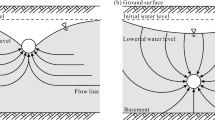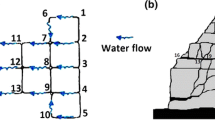Abstract
There are various methods for calculating the inflow of water into excavated tunnels in rock formations, including empirical, analytical, and numerical methods. Analytical equations are widely used due to their simplicity and reliance on assumptions. Results obtained using analytical equations are highly dependent on the tunnel geometry and environmental conditions. Hence, this study employed finite element numerical modeling to simulate the effects of various factors, including fault distance from the tunnel, permeability coefficient, fault width, tunnel radius, rock mass permeability, and groundwater level, on the water inflow into the tunnel. The analytical method was then used to estimate the water inflow, and the results were compared with the numerical modeling outputs. Subsequently, modified equations were developed to estimate the water inflow under different conditions, including cases where the fault intersects or does not intersect the tunnel. The obtained values were within an acceptable range, indicating the validity of the proposed models. Furthermore, the histograms of the residuals for both models showed a good fit. To validate the proposed models, the analytical method and the proposed equations were used to estimate the water inflow into the Amirkabir tunnel, respectively. The results showed that the values obtained using the new equations were closer to the actual values than those obtained using the analytical method. This study highlights the importance of considering various factors in estimating the water inflow into rock tunnels and provides new equations that can improve the accuracy of such estimates.











Similar content being viewed by others
Data availability
Data will be made available on request from the corresponding author.
References
Aalianvari A (2017) Combination of engineering geological data and numerical modeling results to classify the tunnel route based on the groundwater seepage. Geomech Eng 13:671–683
Aryafar A, Doulati Ardejani F, Singh RN (2009) Numerical modeling of groundwater inflow from a confined aquifer into Sangan open pit mine, northeast Iran. Geomech Geoengin Int J 4:189–199
Bang S-H, Jeon S-W, Kwon S-K (2012) Modeling the hydraulic characteristics of a fractured rock mass with correlated fracture length and aperture: application in the underground research tunnel at Kaeri. Nucl Eng Technol 44:639–652
Berkowitz B (2002) Characterizing flow and transport in fractured geological media: a review. Adv Water Resour 25:861–884
Bobet A (2010) Numerical methods in geomechanics. Arab J Sci Eng (Springer Sci. Bus. Media BV) 35
Butscher C (2012) Steady-state groundwater inflow into a circular tunnel. Tunn Undergr Sp Technol 32:158–167
Cesano D (1999) Prediction of groundwater flows into underground conctructions in hard rocks
Chen R, Tonon F (2012) Fracture cluster modeling for groundwater inflow prediction into rock tunnels using geostatistics, in: GeoCongress 2012: State of the Art and Practice in Geotechnical Engineering. pp. 2372–2381
Coli N, Pranzini G, Alfi A, Boerio V (2008) Evaluation of rock-mass permeability tensor and prediction of tunnel inflows by means of geostructural surveys and finite element seepage analysis. Eng Geol 101:174–184
El Tani M (2003) Circular tunnel in a semi-infinite aquifer. Tunn Undergr Sp Technol 18:49–55
Farhadian H, Katibeh H (2017) New empirical model to evaluate groundwater flow into circular tunnel using multiple regression analysis. Int J Min Sci Technol. https://doi.org/10.1016/j.ijmst.2017.03.005
Farhadian H, Nikvar-Hassani A (2019a) Water flow into tunnels in discontinuous rock: a short critical review of the analytical solution of the art. Bull Eng Geol Environ 78:3833–3849. https://doi.org/10.1007/s10064-018-1348-9
Farhadian H, Hassani AN, Katibeh H (2016) Groundwater inflow assessment to Karaj Water Conveyance tunnel, northern Iran. KSCE J Civ Eng. https://doi.org/10.1007/s12205-016-0995-2
Farhadian H, Katibeh H (2015) Effect of model dimension in numerical simulation on assessment of water inflow to tunnel in discontinues rock
Farhadian H, Nikvar-Hassani A (2019) Water flow into tunnels in discontinuous rock: a short critical review of the analytical solution of the art. Bull Eng Geol Environ 78. https://doi.org/10.1007/s10064-018-1348-9
Farhadian H, Aalianvari A, Katibeh H (2012) Optimization of analytical equations of groundwater seepage into tunnels: a case study of Amirkabir tunnel. J Geol Soc India 80. https://doi.org/10.1007/s12594-012-0122-z
Farhadian H, Katibeh H, Huggenberger P (2016a) Empirical model for estimating groundwater flow into tunnel in discontinuous rock masses. Environ Earth Sci 75. https://doi.org/10.1007/s12665-016-5332-z
Farhadian H, Katibeh H, Huggenberger P, Butscher C (2016b) Optimum model extent for numerical simulation of tunnel inflow in fractured rock. Tunn Undergr Sp Technol 60. https://doi.org/10.1016/j.tust.2016.07.014
Farhadian H, Salehzadeh MH, Nikvar-Hassani A (2021) Model dimension effect in DEM and FEM simulations for assessment of water inflow into a tunnel, in: ARMA US Rock Mechanics/Geomechanics Symposium. ARMA, p. ARMA-2021.
Fernandez G, Moon J (2010) Excavation-induced hydraulic conductivity reduction around a tunnel—Part 1: guideline for estimate of ground water inflow rate. Tunn Undergr Sp Technol 25:560–566
Freeze RA, Cherry JA (1979) Ground water contamination. Groundwater. Ontario. Canada 383–456
Gattinoni P, Scesi L (2010) An empirical equation for tunnel inflow assessment: application to sedimentary rock masses. Hydrogeol J 18:1797–1810
Goodman RE, Moye DG, Van Schalkwyk A, Javandel I (1964) Ground water inflows during tunnel driving. University of California, College of Engineering
Heuer RE (1995) Estimating rock tunnel water inflow, in: Proceedings of the Rapid Excavation and Tunneling Conference. Society for mining, metallogy and exploration. INC, pp. 41–60.
Holmøy KH, Nilsen B (2014) Significance of geological parameters for predicting water inflow in hard rock tunnels. Rock Mech Rock Eng 47:853–868
Indraratna B, Ranjith P (1998) Effects of boundary conditions and boundary block size on inflow to an underground excavation—sensitivity analysis. IMWA Proceedings, Johannesbg
Jing L (2003) A review of techniques, advances and outstanding issues in numerical modelling for rock mechanics and rock engineering. Int J Rock Mech Min Sci 40:283–353
Jing L, Hudson JA (2002) Numerical methods in rock mechanics. Int J Rock Mech Min Sci 39:409–427
Karlsrud K (2001) Water control when tunneling under areas in the Olso region. NFF Publ 12:4–27
Király L (1969) Anisotropie et hétérogénéité de la perméabilité dans les calcaires fissurés: avec 3 figures. Eclogae Geol Helv 62:613–619
Király L (1978) La notion d’unité hydrogéologique dans le Jura (essai de définition)
Lei S (1999) An analytical solution for steady flow into a Ttonnel. Groundwater 37:23–26
Lin B, Lee C, Yu J (2000) Analysis of groundwater seepage of tunnels in fractured rock. J Chinese Inst Eng 23:155–160
Maleki MR (2018) Groundwater Seepage Rate (GSR); a new method for prediction of groundwater inflow into jointed rock tunnels. Tunn Undergr Sp Technol 71:505–517
Maleki Z, Farhadian H, Nikvar-Hassani A (2020) Geological hazards in tunnelling: the example of gelas water conveyance tunnel, Iran. Q J Eng Geol Hydrogeol 54. https://doi.org/10.1144/qjegh2019-114
Moeini H, Farhadian H, Nikvar-Hassani A (2018) Determination of the optimum sealing method for Azad pumped storage dam considering seepage analysis. Arab J Geosci 11:1–13
Moon J, Fernandez G (2010) Effect of excavation-induced groundwater level drawdown on tunnel inflow in a jointed rock mass. Eng Geol 110:33–42
Moon J, Jeong S (2011) Effect of highly pervious geological features on ground-water flow into a tunnel. Eng Geol 117:207–216
Nikvar Hassani A, Katibeh H, Farhadian H (2015) Numerical analysis of steady-state groundwater inflow into Tabriz line 2 metro tunnel, northwestern Iran, with special consideration of model dimensions. Bull Eng Geol Environ. https://doi.org/10.1007/s10064-015-0802-1
Nikvar Hassani A, Farhadian H, Katibeh H (2018) A comparative study on evaluation of steady-state groundwater inflow into a circular shallow tunnel. Tunn Undergr Sp Technol 73. https://doi.org/10.1016/j.tust.2017.11.019
Oda M, Hatsuyama Y (1985) Permeability tensor for jointed rock masses. In: International Symposium on Fundamentals of Rock Joints. pp. 303–312
Pan Y-H, Qi J-R, Zhang J-F, Peng Y-X, Chen C, Ma H-N, Ye C (2022) A comparative study on steady-state water inflow into a circular underwater tunnel with an excavation damage zone. Water 14:3154
Rasouli Maleki M (2018) Groundwater Seepage Rate (GSR); a new method for prediction of groundwater inflow into jointed rock tunnels. Tunn Undergr Sp Technol 71. https://doi.org/10.1016/j.tust.2017.10.006
Samardzioska T, Popov V (2005) Numerical comparison of the equivalent continuum, non-homogeneous and dual porosity models for flow and transport in fractured porous media. Adv Water Resour 28:235–255
SCE Company (2005) Site hydrogeology reports for KRJ project
Shahbazi A, Chesnaux R, Saeidi A (2021) A new combined analytical-numerical method for evaluating the inflow rate into a tunnel excavated in a fractured rock mass. Eng Geol 283:106003
Snow DT (1969) Anisotropie permeability of fractured media. Water Resour Res 5:1273–1289
Su Y, Huang Y, Shen H, Jiang Y, Zhou Z (2022) An analytical method for predicting the groundwater inflow to tunnels in a fractured aquifer. Hydrogeol J 30:1279–1293
Su K, Zhou Y, Wu H, Shi C, Zhou L (2017) An analytical method for groundwater inflow into a drained circular tunnel. Groundwater 55. https://doi.org/10.1111/gwat.12513
Zhou CB, Sharma RS, Chen YF, Rong G (2008) Flow–stress coupled permeability tensor for fractured rock masses. Int J Numer Anal Methods Geomech 32:1289–1309
Zhu R, Xia Q, Zhang Q, Cao C, Zhang X, Mao B (2023) Dynamic parameter calibration of an analytical model to predict transient groundwater inflow into a tunnel. Water 15:2702
Zoorabadi M, Saydam S, Timms W, Hebblewhite B (2012) Sensitivity analysis of effective parameters on the permeability of rock mass around a tunnel. In: ISRM International Symposium-Asian Rock Mechanics Symposium. ISRM, p. ISRM-ARMS7
Funding
The authors have not disclosed any funding.
Author information
Authors and Affiliations
Contributions
All authors wrote the main manuscript text, prepared figures and reviewed the manuscript.
Corresponding author
Ethics declarations
Conflict of interests
The authors declare no conflict of interests.
Additional information
Publisher's Note
Springer Nature remains neutral with regard to jurisdictional claims in published maps and institutional affiliations.
Rights and permissions
Springer Nature or its licensor (e.g. a society or other partner) holds exclusive rights to this article under a publishing agreement with the author(s) or other rightsholder(s); author self-archiving of the accepted manuscript version of this article is solely governed by the terms of such publishing agreement and applicable law.
About this article
Cite this article
Farhadian, H., Bahmani Shahraki, F. Enhancing analytical methods for estimating water inflow to tunnels in the presence of discontinuity areas. Environ Earth Sci 83, 339 (2024). https://doi.org/10.1007/s12665-024-11651-w
Received:
Accepted:
Published:
DOI: https://doi.org/10.1007/s12665-024-11651-w




